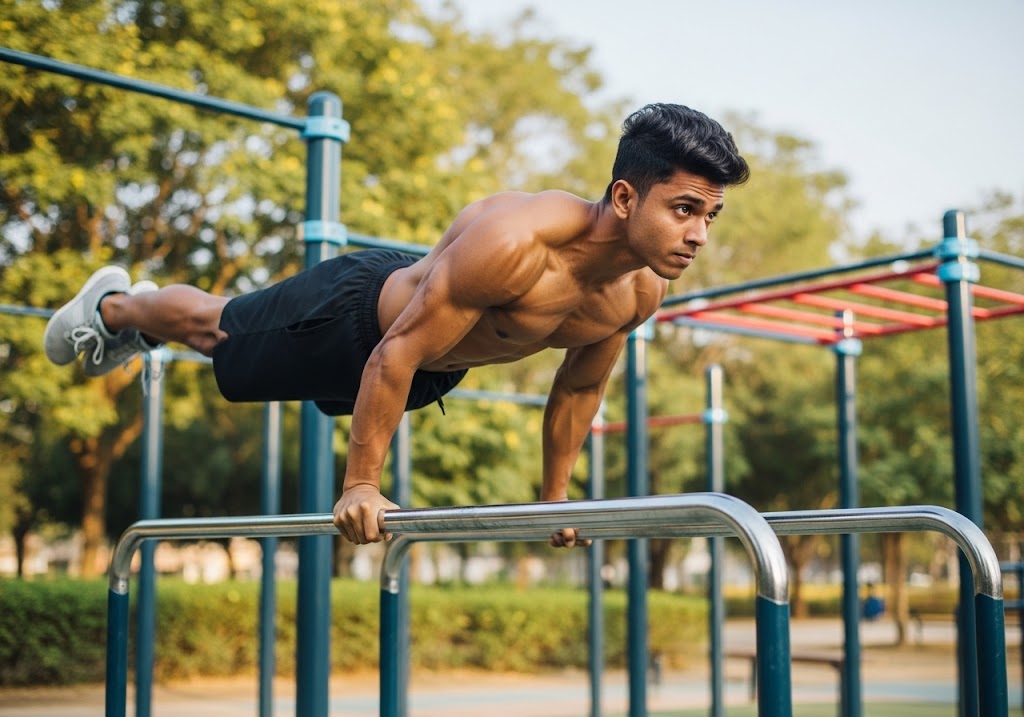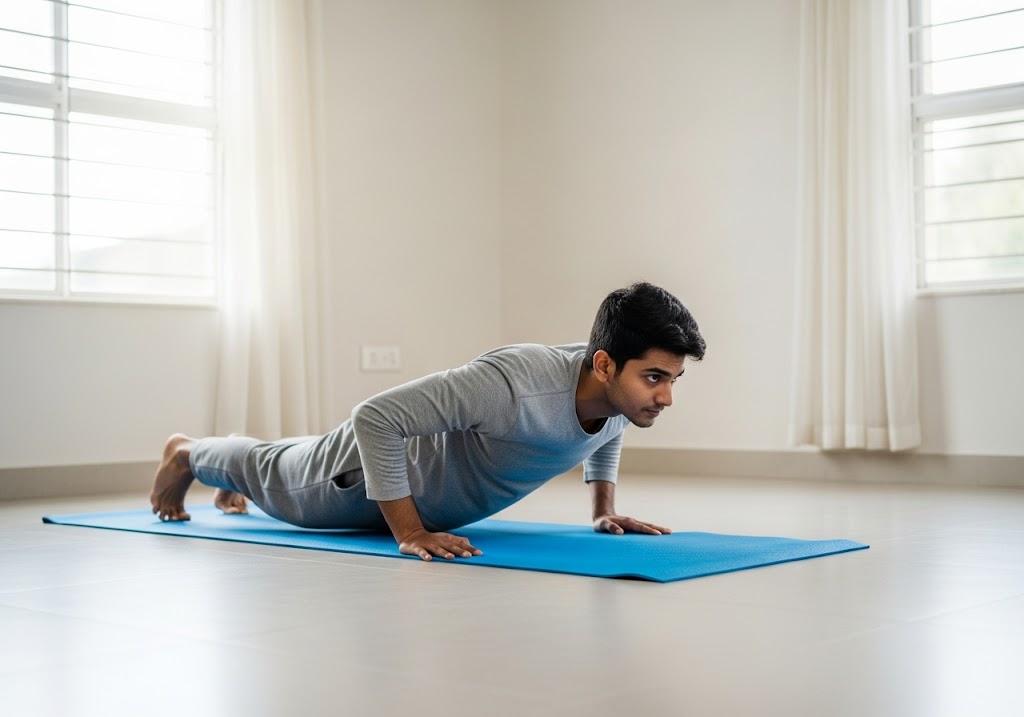Front squat vs back squat differs mainly in bar position, with front squats emphasizing quadriceps and core strength while back squats target glutes and hamstrings more effectively.
Choosing between front squat vs back squat represents one of the most debated topics in strength training. Both exercises build incredible lower body strength, but they target muscles differently and require distinct techniques. Understanding the front squat vs back squat comparison helps you make informed decisions about your training program.
The front squat vs back squat debate involves more than just bar placement. These exercises affect your posture, muscle activation patterns, and strength development in unique ways. Whether you’re a beginner exploring squat variations or an experienced lifter optimizing your routine, this front squat vs back squat analysis provides essential insights for your training success. Most fitness enthusiasts eventually face the front squat vs back squat decision. Some prefer the quad-focused intensity of front squats, while others gravitate toward the posterior chain emphasis of back squats. Both exercises offer distinct advantages, making the front squat vs back squat choice highly individual based on your goals, mobility, and preferences.
Table of Contents
Understanding Front Squat vs Back Squat
The fundamental difference between front squat vs back squat lies in bar positioning and resulting movement patterns. This core distinction creates cascading effects on muscle recruitment, posture requirements, and training adaptations. Understanding these basic front squat vs back squat mechanics forms the foundation for making informed exercise selections.
| Aspect | Front Squat | Back Squat |
|---|---|---|
| Bar Position | Front of shoulders | Upper back/traps |
| Primary Muscles | Quadriceps, core | Glutes, hamstrings |
| Torso Position | More upright | Forward lean allowed |
| Weight Capacity | Lower loads | Higher loads possible |
| Mobility Demands | High ankle/shoulder flexibility | Moderate shoulder mobility |
| Learning Curve | More technical | More accessible |
| Core Activation | Very high | Moderate to high |
| Spine Loading | Lower compression | Higher compression |
Enhance your understanding of different training approaches with our calisthenics vs weightlifting comparison to see how bodyweight and weighted exercises complement each other. Find out exactly how many steps to burn 500 calories.
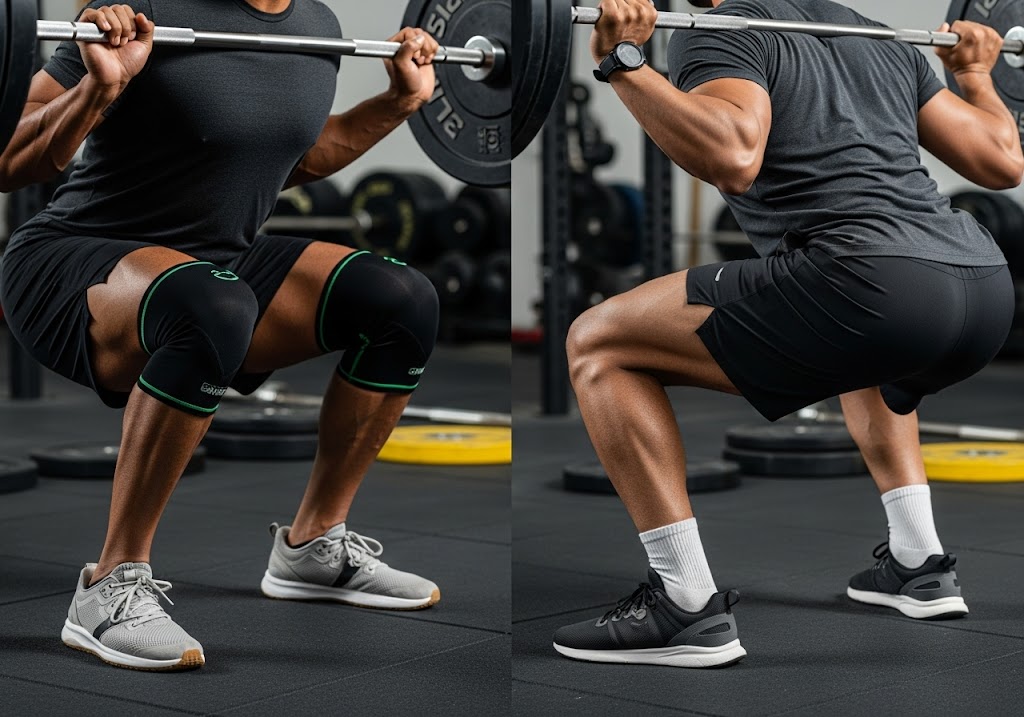
How to do Front Squat and Back Squat?
Proper execution forms the cornerstone of effective front squat vs back squat training. Both movements require specific setup procedures, breathing patterns, and movement sequences to maximize benefits while minimizing injury risk. Mastering these fundamental techniques ensures optimal results from your front squat vs back squat program.
Back Squat
The back squat technique emphasizes hip-dominant movement patterns with the barbell positioned across your upper trapezius muscles. This stable bar position allows heavier loads while targeting posterior chain muscles effectively. Proper back squat form requires controlled descent and powerful hip drive to return to standing position.
Back squat execution follows these essential steps:
- Setup Position – Position barbell on squat rack at chest height, grip bar with hands wider than shoulder-width apart
- Bar Placement – Step under bar, position across upper trapezius muscles, create shelf with contracted upper back muscles
- Unrack Movement – Stand up to lift bar from rack, take 2-3 steps backward, establish stable foot position
- Stance Setup – Place feet shoulder-width apart with toes slightly turned outward for optimal hip mechanics
- Descent Phase – Initiate movement by pushing hips back, maintain straight back, descend until hip crease below knee level
- Ascent Drive – Drive through heels, push floor away, extend hips and knees simultaneously to return to starting position
- Breathing Pattern – Inhale at top, hold breath during descent and ascent, exhale at completion of each repetition
If you’re curious about whether bodyweight training can match weighted exercises, check out our article on can hiit build muscle to understand different training methodologies.
Learn the truth about does pull ups increase height.
Front Squat
The front squat demands exceptional postural control with the barbell positioned across your front deltoids. This challenging bar position forces an upright torso throughout the movement while emphasizing quadriceps and core activation. Front squat technique requires precise balance and coordination to execute safely.
Front squat execution involves these critical components:
- Bar Positioning – Rest barbell on front deltoids with elbows pointing forward, maintain secure grip throughout movement
- Grip Options – Use clean grip with fingertips under bar or cross-arm grip for those with limited wrist mobility
- Posture Setup – Keep chest up, shoulders back, core engaged to prevent forward collapse during movement
- Foot Position – Establish shoulder-width stance with slight external rotation, maintain three points of contact with floor
- Movement Pattern – Descend by bending at hips and knees simultaneously while keeping torso upright throughout range
- Depth Target – Lower until hip crease passes below knee cap while maintaining perfect postural alignment
- Return Phase – Drive up through legs while maintaining upright torso, prevent any forward lean or elbow dropping
For those interested in additional calorie burning methods, explore our how to burn 300 calories a day strategies that complement your strength training routine. Calculate results with 500 skipping burns how many calories.

Front Squat vs Back Squat: Differences Between
The fundamental differences in front squat vs back squat extend beyond simple bar placement to encompass movement mechanics, muscle emphasis, and training adaptations. These distinctions make each exercise uniquely valuable for different training goals and individual capabilities within comprehensive fitness programs.
| Difference Factor | Front Squat | Back Squat |
|---|---|---|
| Bar Position | Across front deltoids | On upper trapezius |
| Torso Angle | Nearly vertical | Forward lean permitted |
| Primary Movement | Knee-dominant | Hip-dominant |
| Weight Capacity | 70-85% of back squat | 100% reference point |
| Grip Requirements | Clean or cross-arm grip | Overhand grip on bar |
| Elbow Position | High and forward | Not applicable |
| Balance Demands | Very high | Moderate |
| Setup Complexity | High technical skill | Moderate skill level |
| Bail-Out Safety | Drop bar forward | More complex exit |
| Equipment Needs | Barbell, rack | Barbell, rack, safety bars |
Explore our how to do plank exercise to develop the core strength essential for both front squat vs back squat success. Build agility and coordination with how to do high jump scissor kick.
Front Squat vs Back Squat: Similarities Between
Despite their differences, front squat vs back squat share many fundamental characteristics that make both exercises valuable for strength development. Both movements activate similar muscle groups and provide comparable benefits for lower body power and functional strength.
Both front squat vs back squat variations offer these shared benefits:
- Compound Movement Pattern – Both exercises work multiple joints and muscle groups simultaneously for maximum efficiency
- Lower Body Strength – Both build significant strength in quadriceps, glutes, and hamstrings through different emphasis patterns
- Core Stabilization – Both require significant core engagement to maintain proper posture throughout the movement
- Functional Movement – Both mimic daily activities like sitting and standing, improving real-world movement quality
- Bone Density Benefits – Both provide weight-bearing stress that promotes healthy bone development and maintenance
- Athletic Performance – Both enhance jumping, sprinting, and sport-specific movement capabilities
- Metabolic Demands – Both burn substantial calories and promote favorable body composition changes
Learn more about optimizing your training with our calisthenics equipment for home setup options.
Front Squat vs Back Squat: Muscle Activation Focus
Research reveals distinct muscle activation patterns when comparing front squat vs back squat exercises. These differences help explain why each variation serves different training goals and why many programs include both movements for complete development.
| Muscle Group | Front Squat Activation | Back Squat Activation |
|---|---|---|
| Quadriceps | Very High | High |
| Glutes | High | Very High |
| Hamstrings | Moderate | High |
| Core/Abs | Very High | High |
| Erector Spinae | High | Very High |
| Upper Back | High | Moderate |
| Calves | High | Moderate |
Studies show that front squat vs back squat muscle activation differs significantly in key areas. Front squats activate the vastus medialis (inner quad) more intensely, while back squats show greater semitendinosus (hamstring) engagement. This front squat vs back squat research supports using both exercises for balanced development.
For comprehensive upper body development to complement your squat training, check out our chest and tricep workout with dumbbells routine.

Front Squat vs Back Squat: Core Engagement & Stability
The front squat vs back squat comparison reveals dramatic differences in core muscle demands. Front squats require exceptional core strength to maintain the upright posture necessary for proper bar position. This makes front squats excellent for developing functional core stability.
Core engagement differs between front squat vs back squat in several key ways:
- Anterior Core Activation – Front squats heavily challenge rectus abdominis and transverse abdominis muscles
- Anti-Extension Demands – Front squats require constant resistance against spinal extension forces from front-loaded weight
- Postural Control – Front squats demand continuous core activation to prevent forward collapse or bar dropping
- Breath Control – Front squats require coordinated breathing patterns to maintain intra-abdominal pressure
- Stabilization Patterns – Front squats develop different stabilization strategies compared to back squats
- Transfer to Athletics – Front squat core demands translate well to sports requiring upright postures
Build additional core strength with our calisthenics for triceps exercises that support overall upper body stability in squats.
Front Squat vs Back Squat: Spine & Lower Back Load
Spinal loading patterns differ significantly between front squat vs back squat due to bar positioning and torso angles. Research indicates front squats may reduce lumbar spine compression through more upright postures, making them potentially safer for individuals with lower back concerns or previous injury history.
| Spinal Load Factor | Front Squat | Back Squat |
|---|---|---|
| Lumbar Compression | Lower | Higher |
| Spinal Shear Force | Reduced | Increased |
| Moment Arm Length | Shorter | Longer |
| Erector Spinae Activation | Moderate-High | Very High |
| Torso Inclination | 5-15 degrees | 15-45 degrees |
| Injury Risk Level | Lower | Moderate |
| Disc Pressure | Reduced | Elevated |
| Recovery Demands | Faster | Longer |
| Suitable for Back Issues | Often yes | Case-dependent |
| Professional Recommendation | Back-friendly option | Requires assessment |
Master strict form with how to do hanging leg raises without swinging.
Front Squat vs Back Squat: Knee vs Hip Dominance
Movement patterns in front squat vs back squat reflect different dominance between knee and hip joints. Front squats emphasize knee flexion and extension, making them more knee-dominant exercises. Back squats allow greater hip hinge patterns, creating more hip-dominant movement characteristics.
| Movement Pattern | Front Squat | Back Squat |
|---|---|---|
| Hip Flexion | Moderate | High |
| Knee Flexion | High | Moderate-High |
| Ankle Dorsiflexion | High | Moderate |
| Forward Torso Lean | Minimal | Moderate |
| Hip Drive | Moderate | High |
| Knee Drive | High | Moderate |
This front squat vs back squat difference in joint dominance explains why each exercise targets different muscle groups more effectively. The knee-dominant nature of front squats emphasizes quadriceps development, while the hip-dominant back squat pattern better targets glutes and hamstrings.
Complement your leg training with our arm workouts with dumbbells women’s routine for balanced muscle development.
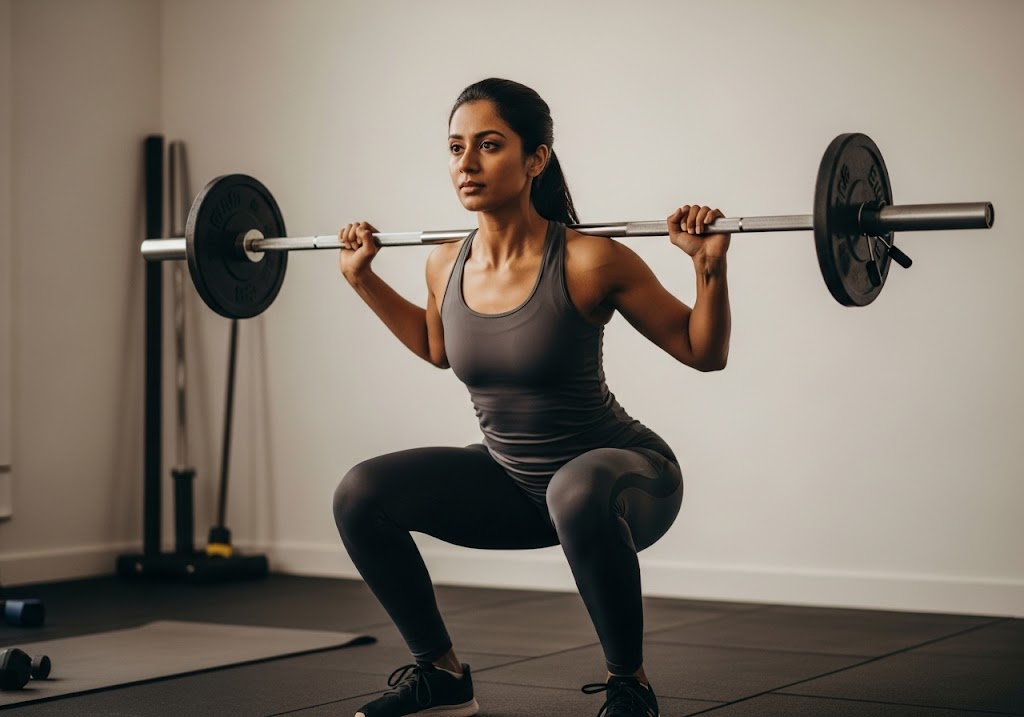
Front Squat vs Back Squat: Mobility & Flexibility Requirements
Mobility demands create significant barriers in front squat vs back squat selection for many individuals. Front squats require exceptional flexibility in multiple joints simultaneously, while back squats demand moderate mobility in fewer areas. Understanding these requirements helps determine appropriate exercise progression.
| Mobility Requirement | Front Squat | Back Squat |
|---|---|---|
| Ankle Dorsiflexion | Very High (20+ degrees) | Moderate (15+ degrees) |
| Hip Flexion | High | Moderate-High |
| Thoracic Extension | Very High | Low-Moderate |
| Shoulder Flexibility | Very High (overhead reach) | Moderate (behind back) |
| Wrist Mobility | High (clean grip) | Not required |
| Overall Difficulty | Advanced | Beginner-Intermediate |
| Time to Develop | 3-6 months | 2-8 weeks |
| Limiting Factors | Multiple joints | Usually hips/ankles |
| Daily Mobility Work | Essential | Recommended |
| Assessment Needed | Comprehensive | Basic screen |
Compare techniques in chin up vs pull up.
Front Squat vs Back Squat: Posture & Upright Torso Position
Postural demands create striking differences in front squat vs back squat execution patterns. Front squats enforce rigid upright positioning that cannot be compromised without losing the barbell, while back squats permit natural forward lean. These postural requirements influence muscle activation and movement quality significantly.
| Postural Aspect | Front Squat | Back Squat |
|---|---|---|
| Torso Angle | 5-15 degrees from vertical | 15-45 degrees forward |
| Chest Position | High and proud | Neutral to slightly down |
| Head Position | Neutral, eyes forward | Slightly down |
| Upper Back Activation | Very High | Moderate |
| Postural Muscles | Continuously active | Moderately active |
| Daily Posture Transfer | Excellent | Good |
| Rounded Shoulder Correction | Outstanding | Limited |
| Desk Worker Benefits | High value | Moderate value |
| Core Postural Strength | Maximal development | Good development |
| Spinal Alignment Training | Superior | Adequate |
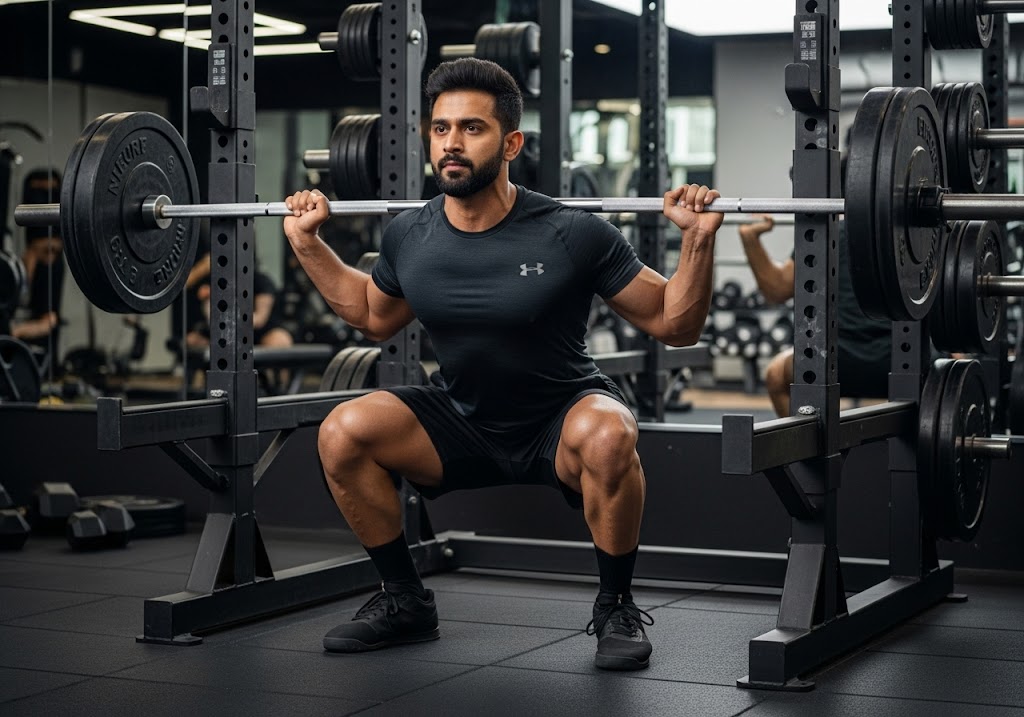
Front Squat vs Back Squat: Strength Development Potential
Strength gains differ significantly between front squat vs back squat due to loading capabilities and movement patterns. Understanding these strength development differences helps optimize your training program for specific goals.
| Strength Aspect | Front Squat | Back Squat |
|---|---|---|
| Maximum Load Potential | Lower (70-85% of back squat) | Higher |
| Quad Strength | Excellent | Good |
| Glute Strength | Good | Excellent |
| Core Strength | Excellent | Good |
| Overall Power | Good | Excellent |
| Functional Strength | Excellent | Good |
| Athletic Transfer | Excellent | Excellent |
The front squat vs back squat strength development potential varies based on your training goals. Front squats excel for developing anterior chain strength and core stability, while back squats better develop posterior chain power and maximal strength capabilities.
For those interested in bodyweight alternatives, explore our how to do jumping jacks exercise for cardiovascular conditioning between squat sessions.
Front Squat vs Back Squat: Learning Curve & Form Difficulty
Technical complexity varies dramatically between front squat vs back squat variations. Front squats demand superior coordination, balance, and mobility, creating steeper learning curves. Back squats offer more intuitive movement patterns that most individuals master relatively quickly with proper instruction.
| Learning Factor | Front Squat | Back Squat |
|---|---|---|
| Initial Difficulty | High | Moderate |
| Time to Basic Competency | 4-8 weeks | 1-3 weeks |
| Coordination Demands | Very High | Moderate |
| Balance Requirements | Exceptional | Good |
| Form Breakdown Indicators | Immediate/obvious | Gradual/subtle |
| Coaching Intensity Needed | High supervision | Moderate guidance |
| Prerequisite Skills | Bodyweight squat mastery | Basic movement patterns |
| Progression Rate | Slower | Faster |
| Suitable for Beginners | After movement prep | Yes, with instruction |
| Self-Teaching Difficulty | Very challenging | Moderately difficult |
Check out our how to do glute bridge exercise to build foundation strength for better squat performance.
Front Squat vs Back Squat: Safety & Injury Risk
Safety considerations play a crucial role in the front squat vs back squat decision. Both exercises carry inherent risks, but the injury patterns and safety concerns differ between variations. Understanding these differences helps minimize risk while maximizing training benefits.
Front squats present unique safety advantages in the front squat vs back squat comparison:
- Easier Bail-Out – Dropping the bar forward is safer and more natural than trying to rack it behind your back
- Lower Loads – Reduced weight capacity naturally limits injury potential from excessive loading
- Better Posture – Upright position reduces lower back injury risk compared to forward-leaning back squats
- Core Protection – Enhanced core activation provides better spinal stability throughout the movement
- Joint Alignment – More natural joint positions may reduce wear and tear over time
- Self-Limiting – Poor form immediately becomes apparent, preventing dangerous technique breakdown
Enhance your overall conditioning with our how many jumping jacks to burn 500 calories workout for active recovery days.
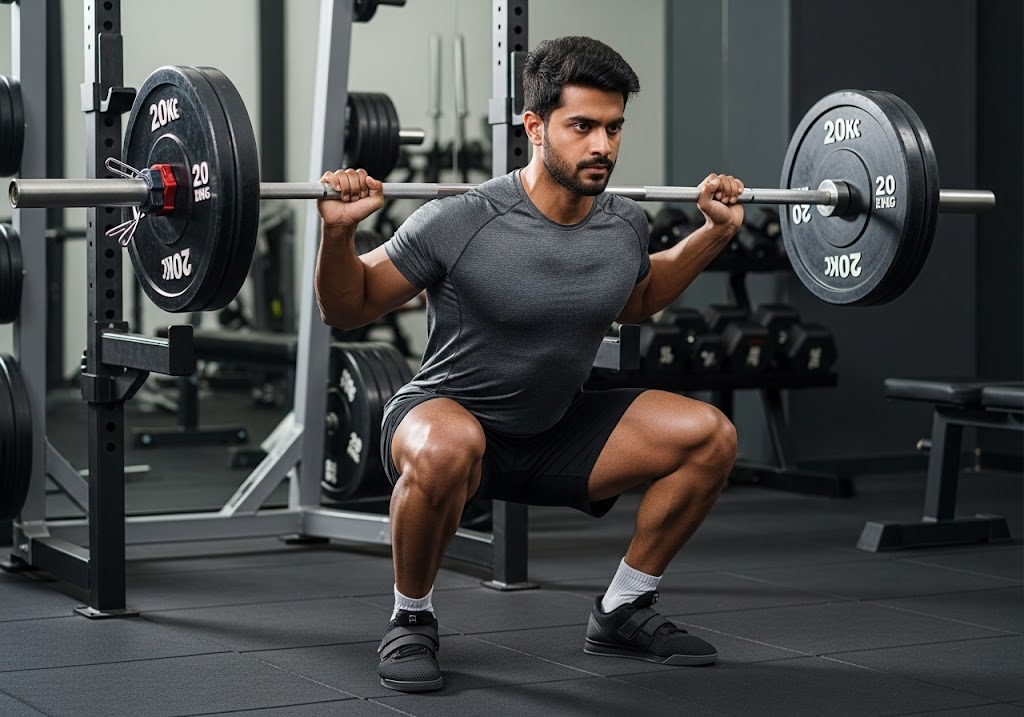
Front Squat vs Back Squat: Physical Benefits
The comprehensive benefits of front squat vs back squat extend beyond simple muscle development. Each variation provides unique advantages that contribute to overall health, performance, and quality of life improvements.
| Benefit Category | Front Squat | Back Squat |
|---|---|---|
| Muscle Development | Quad-focused, core strength | Glute/hamstring emphasis |
| Functional Movement | Daily activity patterns | Lifting/carrying tasks |
| Athletic Performance | Jumping, sprinting | Power, explosiveness |
| Posture Improvement | Excellent | Good |
| Core Stability | Outstanding | Good |
| Bone Health | Excellent | Excellent |
| Metabolic Benefits | High calorie burn | Very high calorie burn |
| Injury Prevention | Lower back protection | Posterior chain strength |
Both front squat vs back squat provide substantial benefits, but the emphasis differs based on the specific adaptation you’re seeking from your training program.
Maximize your workout efficiency with our how to burn 400 calories a day strategies that complement your squat training.
Front Squat vs Back Squat: Common Mistakes
Technical errors plague both front squat vs back squat variations but manifest differently due to unique movement demands. Understanding these common mistakes helps improve technique, reduce injury risk, and maximize training effectiveness while progressing safely in both movement patterns.
Common mistakes in front squat vs back squat execution include:
- Front Squat Forward Lean – Allowing torso to tilt forward due to inadequate core strength or ankle mobility limitations
- Elbow Dropping – Permitting elbows to fall during front squats, causing bar to roll off shoulders and compromising position
- Inadequate Depth – Stopping above proper depth due to mobility restrictions or fear of losing balance in bottom position
- Back Squat Knee Valgus – Allowing knees to collapse inward during ascent, particularly common with heavier loads
- Excessive Forward Lean – Tilting torso too far forward in back squats, shifting weight to toes and stressing lower back
- Heel Lifting – Rising onto toes during descent due to poor ankle mobility, reducing stability and power transfer
- Poor Bar Position – Placing bar incorrectly on neck in back squats or failing to secure front rack position properly
- Breathing Errors – Holding breath throughout entire set or failing to maintain intra-abdominal pressure during lifts
- Rushed Tempo – Moving too quickly through range of motion, reducing muscle activation and increasing injury risk
- Inadequate Warm-up – Attempting working weights without proper preparation, leading to movement restrictions and poor performance
Explore our bodybuilding exercises at home for additional squat progressions and variations.
Front Squat vs Back Squat: Technique
Proper technique forms the foundation of safe and effective front squat vs back squat training. While both exercises share basic squat mechanics, specific technical requirements differ significantly between variations. Mastering these distinctions ensures optimal results and injury prevention.
| Technical Element | Front Squat | Back Squat |
|---|---|---|
| Bar Setup | Front rack on deltoids | High/low bar on traps |
| Grip Style | Clean grip or cross-arm | Overhand, hands wide |
| Stance Width | Shoulder-width, toes out | Shoulder-width or wider |
| Initial Movement | Knees and hips together | Hips lead movement |
| Descent Pattern | Straight down | Back and down |
| Torso Maintenance | Rigid upright | Controlled forward lean |
| Depth Cue | Hip crease below knee | Same depth standard |
| Ascent Drive | Drive through quads | Drive through glutes/hips |
| Breathing Method | Breath at top, hold | Same breathing pattern |
| Safety Exit | Drop bar forward | Step forward to rack |
For additional lower body strength training, explore our hack squat vs leg press comparison to diversify your leg workout routine.
Front Squat vs Back Squat: Variations
Both front squat vs back squat offer numerous variations that can target specific weaknesses, accommodate different equipment, or add training variety. These variations expand your exercise toolkit while maintaining the core benefits of each movement pattern.
For additional upper body training that complements squat performance, check out our calisthenics chest exercises routine.
| Variation Type | Front Squat Options | Back Squat Options |
|---|---|---|
| Grip Styles | Clean grip, cross-arm, straps | High bar, low bar |
| Stance Width | Narrow, standard, wide | Narrow, standard, wide |
| Equipment | Barbell, dumbbell, kettlebell | Barbell, safety squat bar |
| Tempo | Paused, slow negative, explosive | Paused, tempo, box squats |
| Range | Full, partial, deficit | Full, partial, box |
| Unilateral | Single-arm, offset loading | Single-leg, Bulgarian split |
These front squat vs back squat variations allow continuous progression and adaptation as your strength and skill develop over time.
Learn about proper warm-up techniques with our jumping jacks exercise benefits article.
Front Squat vs Back Squat: When to Choose
The front squat vs back squat decision depends on specific goals, physical capabilities, and training context. Neither exercise is inherently superior – they serve different purposes and excel in different situations. Understanding when to emphasize each variation optimizes training results.
| Selection Criteria | Choose Front Squat | Choose Back Squat |
|---|---|---|
| Primary Goal | Quad development, core strength | Glute/hamstring emphasis, max strength |
| Physical Condition | Lower back issues, good mobility | Limited mobility, healthy back |
| Sport Requirements | Olympic lifting, jumping sports | Powerlifting, posterior power sports |
| Experience Level | Intermediate to advanced | Beginner to advanced |
| Equipment Access | Barbell, rack | Barbell, rack, safety bars |
| Time Constraints | Quick core/quad workout | Maximum strength development |
| Postural Needs | Forward head posture correction | General strength building |
| Injury History | Previous back injuries | Shoulder/wrist issues |
| Training Phase | Hypertrophy, technique work | Strength, power development |
| Individual Preference | Enjoys technical challenge | Prefers heavier loading |
Enhance your training knowledge with our how to lift heavier weights strategies for both squat variations.
Conclusion
The front squat vs back squat comparison reveals two excellent but distinctly different exercises. Front squats excel for quadriceps and core development with better spinal safety, while back squats allow heavier loads and better target posterior chain muscles. Your choice between front squat vs back squat should align with your goals, mobility, and training preferences for optimal results.
For more insights on growth and development through exercise, read about does calisthenics increase height to understand exercise benefits beyond strength building.
Want to master the calisthenics handstand and take your skills to the next level? Whether you’re a beginner or pushing advanced skills, ISC – Indian School of Calisthenics offers expert guidance to help you master bodyweight training. Visit us at SRPF Ground, NH8, Goregaon (E), Mumbai – 400065. For class schedules, personalized coaching, or more details, call +91 77159 53218. Train smart, move better, and unlock your back strength with ISC.
Front Squat vs Back Squat – FAQs
What is the main difference between front squat vs back squat?
The primary difference is bar position – front squats place the barbell on front shoulders while back squats position it on the upper back.
Which is better for building muscle, front squat vs back squat?
Both build muscle effectively, but front squats emphasize quadriceps while back squats better target glutes and hamstrings for balanced development.
Can I lift more weight in front squat vs back squat?
Back squats typically allow 15-30% heavier loads than front squats due to better leverages and more stable bar position.
Which is safer for my lower back, front squat vs back squat?
Front squats generally place less stress on the lower back due to more upright torso position and reduced spinal compression.
Do I need better mobility for front squat vs back squat?
Yes, front squats require significantly more ankle, shoulder, and thoracic spine mobility compared to back squats’ moderate flexibility demands.
Which burns more calories, front squat vs back squat?
Both burn substantial calories, but back squats may burn slightly more due to ability to use heavier weights and greater muscle mass involvement.
Should beginners start with front squat vs back squat?
Beginners typically should start with back squats due to easier technique and lower mobility requirements before progressing to front squats.
Which is better for athletes, front squat vs back squat?
Both benefit athletes differently – front squats improve jumping and upright postures while back squats develop power and posterior chain strength.
How often should I train front squat vs back squat?
Most people can train each variation 1-2 times per week, but avoid doing both heavily on the same day due to fatigue overlap.
Can I replace back squats with front squats completely?
While possible, using both front squat vs back squat provides more complete development than relying on just one variation exclusively.
